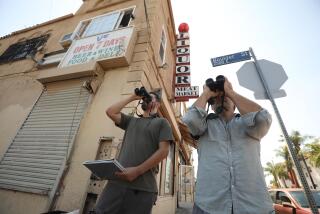Changing Neighborhoods’ Effects on Churches Studied : Demographics: Sociologist is heading an 18-month examination to determine the effects of population shifts. Study may be used to help decide whether to remain or alter congregations’ mission.
- Share via
When neighborhoods change, people get nervous. A chain reaction begins--houses go up for sale, businesses move away and schools may close, accelerating decline and causing thriving communities to suffer economically.
The effects of this phenomenon, labeled by experts as “white flight,” have been well documented. Less carefully scrutinized are the effects on churches: declining memberships, dwindling budgets and deteriorating buildings.
Nancy T. Ammerman, a sociologist at the Candler School of Theology at Emory University in Atlanta, is heading up an 18-month study on churches in changing neighborhoods. She is visiting 27 congregations in Boston, Los Angeles, Chicago, Atlanta and Indianapolis to determine how churches respond to population shifts.
Ammerman is among experts who are compiling demographic studies that may be used to help congregations make informed decisions--whether to remain in an area, leave, consolidate or alter their mission to meet the needs of changing communities.
In some cases, she noted, churches have tried to recoup economic losses by developing revenue-producing programs. In other cases, churches have readjusted their missions to meet the needs of the new residents.
One enterprising congregation, Grace Baptist Church of Anderson, Ind., opened a butcher shop to subsidize its declining budget. Over 15 years, the town lost 15,000 residents because of layoffs at General Motors plants.
In Los Angeles, First Congregational Church adjusted its mission by declaring itself an open and affirming congregation after discovering that its programs were inadequate to meet the needs of its new neighbors, primarily gays and lesbians. A demographic study confirmed that one-third of the population in the changing neighborhood were homosexuals.
“In each case that we studied, neighborhoods had gone through rapid transitions such as suburbanization, economic downturns, plant closings or influxes of minorities or gays and lesbians,” Ammerman said. “In each case, we have documented the results in an effort to assess the range of responses to those changes.”
One denomination, the Southern Baptist Convention, is taking steps to address change, recognizing that when neighborhoods decline and congregations move away, a potential for mission and bringing in new members is lost.
The denomination has hired a specialist in demographics, Earl Nobles, who is charged with assessing changing neighborhoods and presenting statistics to struggling congregations in order to help them review options.
Cultural differences precipitate white fight, he said, adding: “All the denominations--the Methodists, the Episcopalians, the Catholics--are relocating their churches as neighborhoods change.”
Generally speaking, when congregations are growing, the membership mirrors the neighborhood they serve, he said. But congregations with declining memberships often are out of sync with their neighborhoods.
He acknowledged that racism is part of the culture of the church, extending across denominational boundaries.
Ammerman said white flight is “a very common response” in urban neighborhoods that are becoming ethnically diverse.
In general, predominantly white churches in shifting neighborhoods don’t want to reach out to new residents, a reaction that underscores “the difficulty people have in imaging a congregation that is racially diverse,” she said.
Ammerman’s study, which began in April, is focusing on churches of various denominations. She is working in conjunction with the Institute of Economic Culture in Boston, with a $337,000 grant from the Lilly Endowment in Indianapolis.
More to Read
Sign up for Essential California
The most important California stories and recommendations in your inbox every morning.
You may occasionally receive promotional content from the Los Angeles Times.













